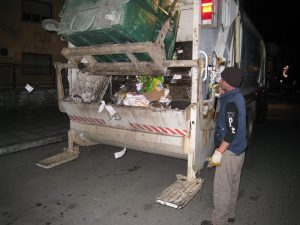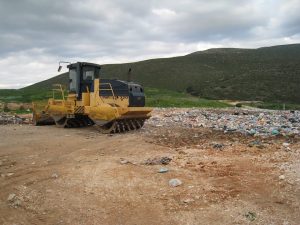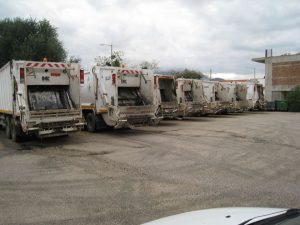In Argostoli the drivers and loaders choose to work Christmas Day, Boxing Day, New Years Day and Easter Sunday to help keep the environment of the city in a pristine condition.
Timothy Byrne
Argostoli is the capital of the island of Kefalonia and has a population of 10,633 people. The city has a modern shopping center and is also the main port for the island, which has a thriving fishing industry. Most people would think of Kefalonia as a holiday destination for the summer months, but once the summer season has finished, Argostoli still remains a busy city. In the Christmas period, many Greek people from the mainland such as Athens, Patras and Killini, travel by ferry to Kefalonia to visit family and friends. They take this opportunity to do their Christmas shopping and to visit the Christmas Fayre which is in the Central Square of Argostoli.
Although large volumes of waste are produced in the summer months, mainly by the hotels, apartments and tavernas, there is still plenty of waste produced in Argostoli throughout the rest of the year, especially at Christmas. Large volumes of waste are produced from Christmas parties, people dining out and the night clubs in Argostoli’s Central Square.
Waste Management in Kefalonia
Waste management on Kefalonia is the responsibility of the Intermunicipal Enterprise for Waste Management and Environmental Protection, which also has responsibility for the treatment of waste for the neighboring island of Ithaki.
Due to large volumes of waste being produced in Argostoli both in and out of season, waste collection is carried out 365 days a year, including Christmas Day, Boxing Day, New Year’s Day and Easter Sunday. This helps to maintain the cleanliness of the capital as well as delivering an efficient and sustainable waste collection service to its inhabitants and visitors.
Waste Collection in Argostoli on Christmas Day
To provide the waste collection service on Christmas Day in Argostoli, the Intermunicipal Enterprise for Waste Management and Environmental Protection use three waste collection vehicles. Two large collection vehicles are used, consisting of an Iveco Trakker 450 6×4 26 tonne chassis fitted with a 22 cubic meter Kaoussis Norba RL300 intermittent rear loading compaction body and Kaoussis comb and trunnion lift which can handle DIN 30700 and DIN 30740 wheeled containers from 80 to 1280 liters in capacity. One of these vehicles completes the largest collection round in Argostoli, concentrating on emptying all of the 1,100 liter roll-top steel containers positioned at communal collection points along its main streets. This vehicle and crew also collects waste left out in plastic sacks by occupants of houses, flats or shared accommodation. This truck’s collection round also involves the collection crew collecting waste deposited in plastic sacks or boxes from residents’ properties in side alleys, off some of the main streets serviced by this truck.
The second collection vehicle used on Christmas Day is an Iveco Eurocargo 190EL28 two-axle 18 tonne chassis with Kaoussis Norba RL300 16 cubic metre bodywork. It has a bin lift fitted to it which is to the same specification as that fitted on the Kaoussis Norba RL300 22 cubic meter unit mounted on the Iveco Trakker 6×4 26 ton chassis. This collection vehicle collects waste deposited in 1,100 liter containers from communal collection points inside the central part of the city, which the 26 ton 6×4 Iveco Trakker 450 cannot reach. This collection truck’s round also includes servicing the side streets of the main thoroughfares in Argostoli as well as collecting all of the waste in the Central Square.
The third collection vehicle used is a Mercedes Atego 815 7.5 ton two-axle chassis fitted with Kaoussis CRV 1000 satellite waste collection equipment. This vehicle also features a bar lift which can empty containers from 80 to 1280 liter capacity DIN 30700 and DIN 30740 types. It is used to service the hospital in Argostoli as well as the tight streets of the city, including the central shopping area, which the two other larger collection vehicles cannot reach because of their size. The compact dimensions of the Mercedes Atego 815 7.5 ton two-axle Kaoussis CRV 1000 satellite waste collection vehicle assists in the efficient collection of waste from these areas.
A total of eight operatives are used to provide the waste collection service on Christmas Day. This includes six operatives for the two larger collection vehicle’s, a driver for each collection vehicle and two loaders for each vehicle, while a driver and one loader are used for the smaller satellite waste collection vehicle. The waste collection service commences on Christmas Day at 5.30am for the two large collection vehicles and around 6.00am for the smaller satellite waste collection vehicle. This is the best time to start because most of the restaurants, taverns and night clubs close at 4am on Christmas Day, so there are minimal volumes of traffic on the streets at 5.30am, thus making the waste collection service very efficient and productive.
Completing the Routes
There are large volumes of waste to be collected on Christmas Day because most of the 1,100 liter containers at the communal collection points are full and there are piles of bags of waste consisting of food waste, glass beer and wine bottles as well as piles of cardboard boxes next to the full 1,100 liter containers from parties held by families on Christmas Eve. Large volumes of waste are also evident in the Central Square of Argostoli stored in piles of plastic refuse sacks containing food waste and glass beer and wine bottles produced by the restaurants, taverns and night clubs surrounding the Central Square awaiting collection. There are also large volumes of waste piled next to the three 1,100 liter containers at the communal collection point of the fish market on Argostoli seafront. This comes from two sources, firstly shoppers buying fresh fish on Christmas Eve, and secondly from the export of fish.
The collection crews of the two large waste collection vehicles empty the 1,100 liter containers at the communal collection points and load the additional quantities of waste in plastic refuse sacks, cardboard boxes etc. into the hopper of the waste collection vehicles. Any remaining debris is swept up by the collection crews and loaded into the hopper of the waste collection vehicles to make sure that all of the waste has been cleared. The collection crews may be clearing waste from some of the communal collection points for 10 minutes if there are large piles of excess waste. The waste collection vehicles’ use their flashing beacons for the duration of the waste collection shift making sure the vehicles are visible to taxis and other traffic.
The waste collection service on Christmas Day takes anything from three to four hours to complete. This is achieved by the hard work of the driver and the loaders deployed on each collection truck. Once the larger Iveco Trakker 450 6×4 Kaoussis Norba RL300 22 cubic meter waste collection vehicle has finished its waste collection round in Argostoli, it heads back to the central depot where all of the waste collection vehicles which service Argostoli, Sami, Agia Effimia, Antisamos, Poros, Skala, Minia, Lakithra, Svoronata, Travliata, Metaxata, Spartia, Lourdas, Pesada etc. are parked. An office is situated inside this central depot where all operational, managerial and strategic waste collection and waste treatment decisions are made for the island.
To the Landfill
The smaller Mercedes Atego 815 7.5 ton two-axle Kaoussis CRV 1000 satellite waste collection vehicle discharges its load of waste into the hopper of the Iveco Trakker 450 6×4 Kaoussis Norba RL300 22 cubic meter waste collection vehicle. The Iveco Trakker 450 acts as a mothership vehicle thus reducing the need for the satellite Mercedes Atego 815 7.5 ton two-axle Kaoussis CRV 1000 waste collection vehicle having to drive to the islands sanitary landfill site.
Once The Mercedes 815 has discharged its load into the hopper of the Iveco Trakker 450 and it has been compacted, the Iveco Trakker 450 is fully loaded with twelve tons of municipal waste. The Mercedes 815 is washed out internally and externally using the washing facilities at the depot by its driver and loader before finishing for the day. The Iveco Trakker 450 heads to the sanitary landfill site for the island at Pallosti towards the north of the island. The landfill disposes of all waste produced across the island of Kefalonia as well as waste from the neighboring island of Ithaki.
By this time, the Iveco Eurocargo 190EL28 two-axle 18 ton chassis with Kaoussis Norba RL300 16 cubic meter body fitted to it will either be already discharging at the landfill or on its way back to the depot because the Iveco Eurocargo 190EL28 goes to the landfill directly after finishing its collection round in Argostoli city.
Once the Iveco Trakker 450 arrives at the landfill site, its load is weighed on the computerized weighbridge. Then it drives to the tip face of the landfill site and discharges its load. A Tana landfill compactor compresses and compacts the load before it is covered with soil. The landfill site complies fully with the requirements of the EU Landfill Directive (1999/31/EC) and is of a bioreactor design. The leachate is collected in an underground tank situated underneath the body of the landfill. The leachate is redispersed through the mass of waste at selected intervals helping to speed up the degradation of the waste. The methane produced inside the landfill is flared off site using a flare torch.
Once the Iveco Trakker 450 has discharged its load at the Pallosti sanitary landfill site, it returns to the vehicle depot at Argostoli where it is washed both internally and externally after the Iveco Eurocargo 190EL28 has been washed.
An Efficient Waste Collection
In conclusion, the island of Kefalonia provides an effective and efficient waste collection and treatment system for the island 365 days a year. The levels of service far exceed those in the UK, taking into account the long running debate with Eric Pickles weekly waste collection fund and the debate about weekly, fortnightly, three weekly and monthly waste collections across England, Wales and Scotland. In Argostoli the drivers and loaders choose to work Christmas Day, Boxing Day, New Years Day and Easter Sunday to help keep the environment of the city in a pristine condition.
Timothy Byrne is a worldwide waste collection and transfer systems consultant and a freelance waste management technical writer based in Birmingham, UK. He has worked in the waste management industry for 20 years. He lives in the UK and has carried out a lot of work and research into waste collection and waste transfer systems in Mediterranean countries. He has also visited New Delhi to carry out research into waste collection and waste transfer systems in India’s capital city. He can be reached at 0044 1384 211001 or 0044 7545 616110 or via e-mail at [email protected].



